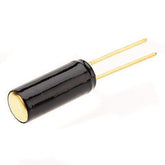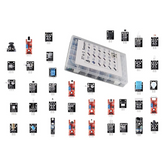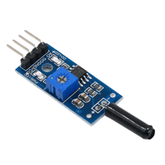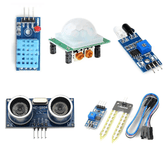Tilt Sensors and Their Role in Maintaining Our Delicate Balance
Summary
Tilt sensors, critical in detecting orientation and inclination, play a pivotal role in modern technology. This blog delves into the different types of tilt sensors, such as electrolytic, capacitive, and MEMS, each with unique specifications suited to varied applications. From ensuring the stability of smartphones and gaming consoles to enhancing safety in industrial machinery and medical devices, tilt sensors are indispensable. Discover how these tiny yet powerful components contribute to our daily lives and the advanced technology around us. Explore the fascinating world of tilt sensors and their remarkable applications!
Introduction
Have you ever been amazed by the sheer power of a fighter plane performing an incredible barrel roll? Perhaps you've seen the incredible beauty of a massive crane that effortlessly moves huge loads across the construction site?
Behind such seemingly easy feats, lies an unnoticed hero: the simple tilt sensor. These ingenious little devices play an indispensable role in a staggering array of applications, from enabling daring aerobatic stunts to ensuring the stability of skyscrapers-in-progress.

However, despite their ubiquitousness and significance the tilt sensors are often under the radar, working at their best to impart important data on inclination which ensures that our world runs well.
Understanding Tilt Sensors
In their essence, the tilt sensors are transducers that determine the angle of tilt or inclination relative with a plane, usually the vertical or horizontal axis. It sounds simple enough you think?
The real genius lies in the variety of technology these sensors use to detect shifts in orientation. In everything from balls that roll to suspended mass tilt sensors employ an array of clever mechanisms to produce an electrical signal proportional the tilt.

The signal is processed and used by different systems, which allows precise adjustments and monitoring in real time of tilt. It's similar to having a tiny electronic spirit level that is constantly monitoring the globe's position.
Types of Tilt Sensors
Exploring the Diverse Technologies Prepare yourself and be ready, as this world is an incredibly diverse and exciting one.
From the tough heavy-duty aircraft sensors to the tiny gadgets of consumer electronics every kind of tilt sensor has their own advantages and disadvantages on the line.
It's a smorgasbord of technology catering to the various preferences of various applications.
Force Balance Sensors:
The Gravity-Defying Workhorses Let's begin with the most reliable of the tilt sensing industry Force balance sensors, also referred to as sensors that are gravity-referenced.
These devices are built to deliver high-precision DC accelerometers, which makes them the best option for applications such as maritime, aviation as well as seismic monitoring.
Imagine a sensor that is so durable and trust-worthy that could endure the most extreme of conditions such as hot deserts to frozen tundras and still maintain its unflinching quality. This is the hallmark of the force balance sensor.
With their wide measurement range and a high level of precision these sensors are able to detect even the most subtle of inclinations, making sure that your plane stays on track and your offshore equipment remains level - regardless of the challenges Mother Nature throws your way.
MEMS Sensors:
The Miniature Marvels of Tilt Detection In the realm of miniaturization, MEMS (Micro-Electro-Mechanical Systems) tilt sensors reign supreme.
They are tiny wonders that, which are often smaller than the size of human hair, function like ants from the future - packed with a staggering quantity of energy and precision in their tiny frames.

Making use of movable proof plates and suspension systems that are mechanical, MEMS sensors can sense the tiniest shifts in the direction of movement, making them ideal companions for medical devices, consumer electronics and aerospace applications.
Imagine your smartphone easily changing the orientation of its display as you tilt it or a surgical robotic staying in a precise position in a delicate operation This is the strength that comes from MEMS tilt sensors in action.
Fluid-Filled Sensors:
The Electrolytic and Capacitive Wonders For applications that require exceptional accuracy and sensitivity, the fluid-filled tilt sensors are a distinctive and innovative solution.
They can further be classified into capacitive and electrolytic kinds, each having distinct working principles and capabilities.
Electrolytic sensors depend on the fluid's imbalance between electrodes to gauge the inclination of the device, much like tiny, liquid-filled spirit level that constantly adjusts with the slightest tilt.

Capacitive sensors, on contrary, are able to detect changes in capacitance triggered by the motion of a central mass It's similar to having a tiny gravitational sensor hidden inside your device.
Both instruments excel in precision as well as industrial automation offering high-quality tilt measurements across diverse settings.
If you're trying to calibrate sensitive instruments for research or making sure the precise position of robotic arms in an assembly line fluid-filled tilt sensors have the job covered.
Specifications
Decoding the Critical Parameters Let's face it choosing the best sensors for tilting your needs may feel like having to wade through a maze of technical terms and specifications.
Don't fret you're not alone, as we will guide you through the maze with precision and (hopefully) some amusement to entertain you all the journey.
Number of Axes: Choosing the Right Dimensionality
One of the most important things to consider when choosing tilt sensors will be the amount of axes that are required to meet the requirements of your project. Imagine it as selecting the best pair of glasses.
You would not want an axis-only lens when you're looking to see the world in its multi-dimensional splendor, do you?
Single-axis sensors monitor inclination on one plane, similar to an intricately observing seesaw's changes and ups.
Tri-axis and dual-axis sensors in contrast, grant comprehensive coverage of two and three axes respectively. They are ideal for tasks which require a wider perspective of tiltscape.
Resolution and Measuring Range:
Resolution and measurement range are the yin and yang in specifications for tilt sensors. They are two forces that have to be carefully weighed in order to complete harmony (and precise measurements, of course.).
Resolution is the smallest change that can be detected in inclination. This is akin in sensitivity to a precisely tuned seismograph.
The measurement range is, however is the range of angles at which the sensors can measure accurately similar to the boundaries of a game field and over where all bets are off.
The right balance between these two parameters is essential to assure reliable performance and avoiding measurement mistakes.
A high resolution without a sufficient measurement range is similar to using a high-powered telescope on a small portion of sky. You'll lose the bigger image.
In contrast, a large measuring range but with poor resolution is similar to reading a fine prints using binoculars and struggle to see the small specifics.
Sensitivity, Noise Tolerance, and Output:
When you thought we'd got it all covered There are three additional crucial specifications to be considered such as sensitivity, noise tolerance and the output type.
Sensitivity is the ability of a sensor to sense and respond to small variations in inclination. It's like an ear tuned to the smallest whispers of tilt. Noise tolerance is the opposite.
It guarantees accurate measurements even when there is external noise - because we all know that the world can be noisy.
Then, there's the type of output either digital or analog which affects the possibility of integrating with other systems as well as the amount of signal processing that is required.
It's similar to choosing between an uninterrupted, smooth audio stream or clear digital representation - each having its own benefits and disadvantages.
Applications
Enabling Innovation Across Industries After having delved into the inside workings and specifics of their tilt sensor, we can examine the wide array of applications for which these nebulous devices shine.
From ensuring that our skies remain secure and stable, to the ability to precisely position and move in robotics tilt sensors are invisible heroes that drive innovations across a wide range of industries.

Aerospace and Aviation:
In the incredibly high-risk world of aviation and aerospace tilt sensors play a major part within flight control mechanisms as well as stabilization mechanisms for aircraft.
Imagine a pilot who is daring sufficient to execute the stomach-churning barrel roll their aircraft swaying and turning across the sky with stunning precision.
In the background, a variety of tilt sensors work hard to assure that each maneuver can be executed precisely precision and maintaining your pilot (and food) well-in control.
However, it's not only the thrill seekers who benefit from these clever devices. Commercial airlines, too, use tilt sensors to deal with turbulent weather conditions and ensure the flight's stability and smoothness since, let's face it no one wants their on-board drink to end up on their lap.
Robotics and Automation:
Enabling Precise Positioning and Movement In the field of automation and robotics tilt sensors play a crucial part in providing precise positioning and movement.
From industrial robots that are on assembly lines to autonomous vehicles, and even humanoid robots.
These sensors are the unspoken heroes that warrant our robots are operating with unmatched precision.
Imagine a robotic arm seamlessly creating a complex machine, with its movements being guided by precise data on inclination supplied by tilt sensors.
In real-time, orientation tracking technology, automated systems can adapt and adjust according to the environment around them, making sure that each component is precisely placed and that every move is performed with precision.
But the technology doesn't stop there. Imagine a self-driving car driving through a mountainous road with its tilt sensors continuously keeping track of the vehicle's direction and relaying the information to controllers, allowing precise steering adjustments while maintaining stability in the most treacherous terrains.
Construction and Heavy Machinery:
Ensuring Stability and Safety In the rough and harsh landscape of construction sites as well as mining operations tilt sensors play an essential role in ensuring stability and safety of heavy equipment.
Integrated into systems like excavators, cranes and off-road vehicles, these sensors serve as guardians, continuously checking the angle and preventing accidents like rollovers and other dangerous scenarios.
Imagine a massive crane carefully navigating huge loads with the elegance of a ballet dancer each step controlled by the constant vigilance of the tilt sensor.
Or, imagine a massive excavator that is perched on an incline that is steep with its tilt sensors providing the vital information required to keep the balance intact and avoid the possibility of a devastating tipping accident.
In high-risk areas, where safety is the most important factor Tilt sensors are the unnoticed guardians constantly working to safeguard employees and assure the smooth implementation of even the most challenging construction projects.
Consumer Electronics and Gaming:
Enhancing User Experiences While tilt sensors could appear to be the preserve of industrial applications and high stakes These versatile devices have made them into daily lives, changing how we interact with gaming and consumer electronic devices.
Think back to that last time when you tilted the screen of your phone to rotate the screen, or played a game that was motion-controlled that seamlessly guided your screen character by the subtle motions of the controller.
In the background the tilt sensors were working, translating your intuitive gestures to precise inputs changing your phone into the extension of your mind and body. But the possibilities don't end there.
Virtual real-world headsets, augmented and virtual reality applications, and fitness trackers all rely on the capabilities in tilt-sensing technologies to provide an immersive experience and precise monitoring of our movement. It's like having an orientation guide, continuously monitoring and adapting to every turn and tilt.
Other Applications:
From Human Movement Studies to Thermostats As if that the possibilities of with tilt sensors can't be more varied We venture into the world of human movements and thermostat design. beyond.
Within the realm of biomechanics as well as rehabilitation Wearable tilt sensors serve valuable insights into gait, posture, as well as general body mechanics.
Imagine tiny electronic coaches continuously monitoring your movements and giving you feedback based on data to benefit you improve your performance or heal from injuries.
Even something as basic as thermostats can benefit from the accuracy in tilt sensors.
Adjusting for the angle of the device, these insignificant aids assure exact temperature control, which can prevent expensive overcooling or overheating scenarios.
From the deeps of the oceans to the vast expanse of space tilt sensors have proven their ability time and time again and are constantly pushing the limits of what's possible, and even enabling technologies previously thought to be unattainable.
Conclusion
We are in the midst the beginning of an technological revolution technology for tilt sensing is full of potential, capable of shaping and molding things around us, in ways that we cannot even imagine.
Innovations made in MEMS technologies and the miniaturization of them are paving the way for more compact, more efficient and robust tilt sensors, which will allow their integration into an ever-growing variety of applications and devices.
Imagine fabrics that be able to detect and adjust to every move and small medical devices that detect and correct imbalances in your body with pinpoint accuracy.
However, the real game-changer is in the rise of machine learning and artificial intelligence algorithms.
Through the use of the massive amounts of data generated through tilt sensors advanced systems will be able learn, adapt and even predict patterns of inclination and open new realms of possibilities in fields such as autonomous maintenance, predictive navigation, and more.












